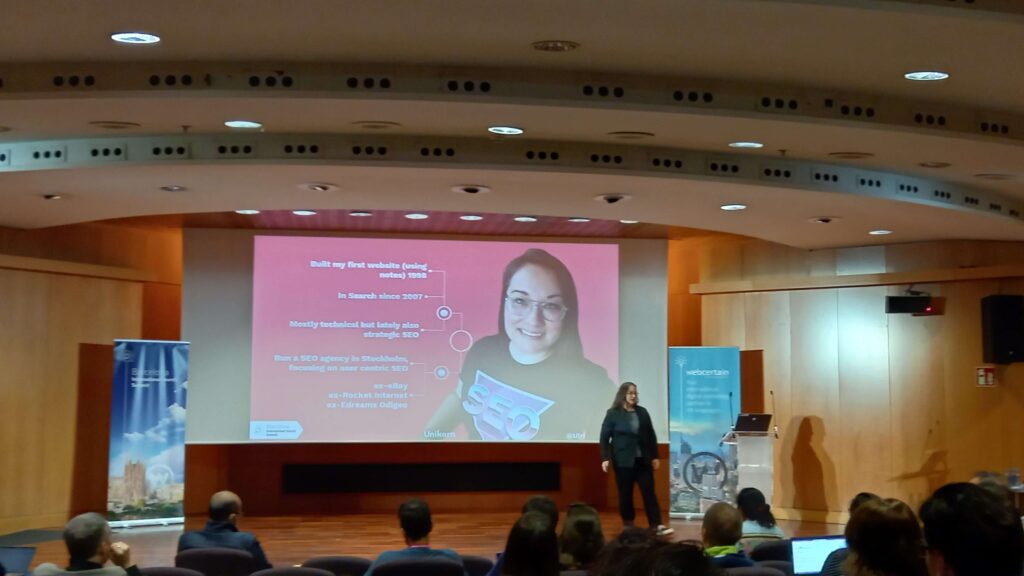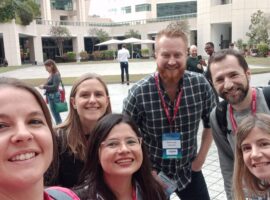Autumn in Barcelona means International Search Summit is back. This year was the biggest event they have had to date. I first went to International Search Summit in September 2012 when it was in New York City. I have been a fan of it ever since.
There were three tracks with speakers from over 30 countries. I wrote a recap of the day from the sessions I attended. Webcertain will be sharing the slides of all those who spoke and the recordings too soon.
Meanwhile here is gallery of some of the photos from the day.
Link building for international targeting
Rad Pauluszak – Husky Hamster
Rad started the Content Track with his presentation about link builiding sharing his case studies from his company Husky Hamster.
Rad talked about two case studies that show that Google still pays to attention to the link profile of your site.
Case study 1
The site was 18 months old and the team were building 4 – 5 links a month only in one language. They first stared building links in Spain and LATAM. Then they increased the links per month to 6 and traffic started to increase. However, after they built links from English sites, they saw a drop in traffic.
Case study 2
The site is a lottery site in Argentina site for the lottery. Initially they built 10 links then 4 to 6 a month. The site went live Feb 25th. There was initially growth of the domain. They built 4 – 5 links per month for LATAM and Spain. Then added the EN links and this saw a drop of the traffic. Then there was the Helpful content update and the traffic dropped.
It shows that having English links was irrelevant for this site in Argentina and it negatively affected the site.
Take aways
- Use folders instead of subdomains – keep all under one roof.
- Link power compounds at the domain level
- Subdomains are usually treated as different entities
ccTLDs and gTLDs can undergo language change
- In the past only gTLDs were affected by international targeting.
- NOW current ccTLDs can also change their country targeting and it is controlled by the algorithm
International link building rules
- You can leverage links from a country that is less competitive, for example Brazil instead of looking only at Portugal.
- Link from other countries can get you a lot of link juice
- Link from the language you have on the targeted page
- Use hreflangs
- Do not over use links from languages or locations you do not support.
Cross-cultural digital PR strategies
Laura D’amato from Verve Search gave an interesting presentation at International Search Summit. She shared some great examples and tips to generate more coverage.

Agenda:
- Get started
- Content
- Outreach
How do you define your KPIs?
- Define with the clients. What success means depends on many – the resources, the market. Do your research.
- Look into your competitors, can you do something different? Look at the industry in general.
- Start with realistic targets. If in a new country, then it may be hard to get as much traffic increase.
- Focus on top-tier publications
- Hire a native speaker as they know the language and the media landscape and they have a cultural approach that no one else has.
Laura says when hiring she looks for this: Autonomy, persistence, adaptability and curiosity.
Being the only native speaker for one market, can be hard. Do not forget to check in and give them support.
Content that travels
- Can you just translate a campaign that worked well in one country and got a lot of coverage? Laura does not recommend this. Laura shared a case study that did not work.
- It was not a fit for the journalists and the audience.
- Journalists may not be used to being approached by digital PRs
3 Learnings for your content to go global
- A story that is culturally relevant for journalists and audience
- A solid methodology.
- A campaign with several stories. If you have one story then maybe it doesn’t work.
The local approach
We need to get coverage for a beauty brand. We looked at journals and papers and the regional press is very strong. Regional pride is very strong.
Verve Search took a well known headline and analyzed in a different way which was “Where are the happiest cities in the world”
They therefore decided to look and analze the faces of celebs who were the happiest in the photos in those different cities to see if they are happy or sad according to Instagram.
You could also use this approach on events such as the World Cup and have the happiest and saddest footballers.
Why use global approach?
- For countries with smaller media landscape
- Can reach several countries with one campaigns
- To expand your backlinks profile
Creating a campaign with a global appeal can be tricky.
- Decided to focus on an issue about property prices pricing out locals. Did a campaign. Was very powerful. Told the same stody in each location.
- The issue was gathering the data for tmore than 300 cities around the world.
- Laura said we had to build up authority to then outreach to journalists.
- Focused on clear and simple data points. Had one metric the 5 year comparison.
- Went out with more than 40 different stories for 15 countries.
Steps to go GLOBAL
- Prospecting is the first one
- Media platforms
- Social media
- Author biographies
- Local global – important to use the experienced Digital PR, use interesting sublinks.
Global approach
Start by targeting UK and US top tier publications, more geneatl that gives overview of the sotory.
One tip per country
- FR – provide a number
- In Spain – target editors who will redirective content to freelancers and follo ups v important
- Denmark – They say yes will do it be do not
- Sweden – be approachable and cultivate
- Norway – very strick rules with sources.
- Germany – don’t expect coverenage to go live straight away.
- USA – provide state by stage data
- Argetina – target editors, Argentina can be interested in EU data.
Why most international digital PR campaigns are also missed opportunities
David White is always so energetic when giving his presentations. He always shares so many tips as well. David is Head of Content Marketing at connective3 and at International Search Summit he shared an exceptional presentation about the fact that links should not be a tick box exercise, it should deliver real business growth.

David said there was a lack of collaboration which would reduce your digital PR impact. Links should be more than just a number on a spreadsheet. The links need to drive real business growth so you need to collaborate withthe other teams around you.
Questions you should be asking your SEO team?
- What keyword categories/topic are we looking to drive visibility growth?
- What is happening in the competitor landscape
- How many campaigns/links are competitors acquiring?
Questions asking paid team
- What are the top converting domains from display?
- What audience data do you have?
- What current ads are yo running?
- Who are the most engaged audiences and channels?
Questions asking your social media team
- What questions are most commonly asked on social media?
- What audience data can you share?
- What are the highest engagement times?
- Which influencers are we working with?
Then David did a walk through about Blacktower financial management.
Make sure you have always an “always on approach”
- Reactive
- Planned
- Proactive
Campaign work is only 60 to 70% of the link opportunity in front of you. David suggested to use all of your resources and your team to generate more links and exposure.
- First of all, David spoke to the customer service team, what issues customers were having. He also used Alsoasked.com. He wanted to create content that customers could use. David suggests to speak to your SEO/Paid teams
- David created relevant content with an audience pool. He shared that example that Spain is the bst EU country for retirees and Iowa is the best US state for retirees.
- Use audiense.com and sparktoro.com as it shows all the sites people visit your site but where they go as well.
- Look at ahrefs, where are the competitors getting links and you are not.
- Got coverage on tv and radio – this is great, loads of journalists pick this up.
There were impressive results. His team generated 180 links, 86,7k special shares, 8.77 million in terms of est online coverage.
AND he saw a 194% increase in conversion rate and a decrease in CPA.
This was an excellent presentation David.
International SEO audits, how to develop and prioritize them for impactful results
Aleyda Solis shared many tips on how we can prioritize audits and elements to change on websites to generate results that make a difference.
Targeting international markets can be a great way to diversify and scale your business online. Google has become much better at understanding language with BERT and now with MUM. They have become better at understanding language.
International sites decreased their rankings/traffic from non-relevant markets during recent Google Updates. But rankings across competitive industries in international markets can be tough.
There are important well-known optimization challenges through the internationalization process. For example, targeting non-profitable markets, ranking with the wrong page.
How to tackle the challenge of international SEO audits with these 3 steps:
- Focus on impactful international optimization actions
- Provide solutions to facilitate implementation
- Help to establish system to avoid execution mistakes.
Focus on impactful international optimization actions
Your international SEO audit should assess on those core areas influencing targeting, geolocation and localization

- Targeting – you do not need to target all markets at same time just cause the industry leaders are doing this.
- OR do you do not need enable all language versions for every country you target.
THIS IS HOW you end up with the common issue of NOT having resources for localization or optimization.
- Don’t have a footer if you do not have the content for these pages.
- Check if there is minim search traffic potential for profitability to prioritize your efforts on them. Use Aleyda’s International SEO ROI checker.
- Google supports language and country targeting but not “continent” which should be avoided.
- It is about supply and demand. Always check and validate (keyword research per market) to assess how much the term variations change per country.
JDSports target countries va ccTLDs and AO via subdirectories with gTLDS, both approaches are valid. BUT check the SERPs, which are the type of domains ranking for those terms. Use SEOminion to help you.
Provide solutions to facilitate implementation
- BE consistent. For example Aleyda found some Spanish sites which had Spanish content within the EnglishURLs.
- Do a list crawl of your different international web versions’ home pages with the google user agent to validate it.
- Use HTTP Status tool
- Improve your international pages crawlability and popularity by cross linking between them with crawlable links, allowers user to switch too.
Help to establish system to avoid execution mistakes
Although Hreflang continues to provide a way to specific language/country per page and alternates, Google has deprecated the report from the Search Console.
ONLY add hreflang to pages that cannibalizes the pages. Identify those pages in GSC. Add it to the categories that have the issues.
Let us focus on what needs we care about. Then you can effectively improve your results with the desired markets, even when using gTLDs.
Going native can make or break a business so make sure you are making the most of all the opportunities.
Backlink auditing for international expansion (when you don’t speak the language)
Sophie Gibson from StudioHawk gave a great presentation where she walked through the step by step process of using different formula in Google sheets on how we can do backlink audits.

Sophie went through the reasons of why we audit backlinks when expanding internationally. We want to give the PR team a specific direction.
- Find Link Gaps
- Translate
- Group Data
- Analyse
Use a competitive research tool eg Ahrefs
- Do a link gap analysis. Once identified the competitors, try and find those sites.
- Then qualify the links and export.
- Filter out the spammy keywords. Then import the file created.
Translate
- Use a translated meta descriptions to identify target link categories.
- Extract full URLs, get maneta descriotpns and translate them. (GET URL).
- Sophie then showed us how to use the “IMPORTXM” I will need to view her slides again as there was a lot of great steps. –
- Use Google Translate = can use some nice automatic translate.
Group Data
- Use list of site categories – this is manual
- Create RegEx String =Join(“|”,A1:A)
- Group by category
- Use the countif
Analyse
- Use the grouped data to find trends and uncover PR angles.
- Fashion, there were many domains and average DR is high. Can you create a story? Maybe you want to target a specific site, eg Vogue.
- Can we combine angles, wedding and travel so weddings abroad. Or clothes for different wedding travel location.
- SOOO what Now?
- When do this from one market, repeat process for other markets.
Hreflang done right, to save the day for the International SEO
Ulrika Viberg who runs her own Unikorn agency in Stockholm gave a great presentation about herflang at International Search Summit.

Ulrika asked Twitter for the hreflang Twitter horror stories and there are many.
One example has 38 market and had 6 languages so there are 228 hreflangs per URL. So these are really big sitempas. They are too big.
Hreflangs are links. If you have links between them, they do share ranking signals theredfore it is saving search bot a lot of resources. This means you do not need to recrawl every copy.
Sooo what can you do?
Make sure your platform/CMS can handle hreflang set up
- If you are planning on going international, invest in a platform to handle the site.
- Make sure you have control of the hreflang setup.
- Google uses algorithms to determine the langage, not language. or hreflang.
Less is more
- Just because you can combine every country and language, then you should not.
- 5 versions of English in each market is too much.
Check your internal links every now and then including hreflangs
Check what SERPs your site shows up in
Stop Focusing on Search Volume
Liraz Postan spoke on about search volume and how we should stop looking and chasing those terms with high search volume. This is something I have suggested with some clients but have sometimes gotten push back as they only go after the big terms.

What is low search volume?
- It is what Google tells us from Google keyword planner (or from other tools as well).
- 40% of us are still ignoring low search volume.
- We need to tie the right content to the right KPI. CMO or Marketing needs education. Lirasz used to create a monthly SEO session that was so valuable for them.
Low search volume will get you the following:
- Higher intent
- Less exposure
- Less brand awareness
- BUT likely to convert
HIGH Search volume will get you the following:
- Low intent
- Mostly browsing
- High competition
Another tool to use is Also Asked com. Keep it simply.e Every tool you like. You can use it to give you the detail.
Why Aim for low?
GA4 analytics had zero searches 14 days after launch but it is still important. It captures the trends and get the traffic
Lirzas talked about a case study where she launched 100 pages with very low search volume as a starting point. They instantly ranked 1 to 3. After that was a success, she launched around 5k pages using the same template and these were the results:
- Localization took time and managed to localise only 20% of the new site per language.
- +105% in traffic growth
- +25% increase in conversion rates.
Takeaways
- Be smart about it.
- Where it the satisfaction
- Are you bringing the right people to the right content.
There were a lot of great insights from Liraz that I was not able to capture. I would suggest to follow Liraz on Twitter and ask for more information.
How to include audio and video as part of your international search strategy
Azeem said that if you have an international strategy in place, then you need take this to the next level.

Hot take:
We get the measurement wrong. As of Jan 2022, thre are nearly 16millon ways of tracking ROI of digital marketing. Too many ways.
We know what our customers want but we do not know how they want it.“Content velocity” it is measuring amount of content puts out during defined period of time. DO not measure yourself at that.
Azeen said go from basic to advance in three steps.
- Basic
- Better – UA data shows us our longest path has 9 touch points
- Advanced
We have split out our top 5 markets in GA4 and understand which countries prefer audio/video more.
- Go back and see the top conversion paths. Have a look at that and start from bottom up. NOT most popular path.
- When you become advanced, in GA4 you can split out the which channel driving the most traffic in any country and use that to tailor the content. To do this in GA4 then have to set this up in GA4.
- In GA4, you can see how much video progressed or started, you can see scroll, depth or anything else.
- When put the two together, see how far users are scrolling (in Italy) and how much of which video is.
How can you use this information?
- In France there is low scroll and high video time. SOOOO create long form videos and include them early in the arace.
- If you know these users wont scroll, give them want they want.
- In Spain, they do deep scroll and no video time. So do not give them a video. Give them a landing page to boost conversion rate.
- In Germany, they have low scroll and low video, then look at shorter videos earlie in the purchase. Get them early in the journey.
- There is a massive disconnect with what user expects vs what they are getting.
- There is rising demand for podcast, audio tweets and audiograms to drive traffic.
- Simply by adding a guest headshot and a snippet of audit, Azeem reached over 700 people. It cost £0.
- Landing pages that include video, convert better.
FInd out what your customers do and then work on that. Lidia and Azeem did a talk about TikTok.
Azeem started doing video with the podcast and generated 1,726 views.
- Repurpose old contnet eg blogs that are text only- record audio “teaser” snippet and release across multiple platforms.
- Use video to show and tell about your client.
- With ecomm – do “How to” od demo with audio and video and their benefits
People BUY FROM People
- Get on GA4
- Understaad which countries want video
- Barrier to entry is low and cheap
- Segment your seach strategy in this way.
There were so many insights from the speakers, I could not capture them all. If you want to hear from the speakers, please contact them directly and if you want to attend International Search Summit next week, book your place. I was lucky enough to be a media partner this year and hopefully next year too and I can share the discount code with you.






